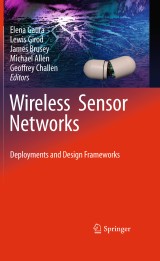Details

Wireless Sensor Networks
Deployments and Design Frameworks|
149,79 € |
|
| Verlag: | Springer |
| Format: | |
| Veröffentl.: | 14.09.2010 |
| ISBN/EAN: | 9781441958341 |
| Sprache: | englisch |
| Anzahl Seiten: | 290 |
Dieses eBook enthält ein Wasserzeichen.
Beschreibungen
The twentieth century ended with the vision of smart dust: a network of wirelessly connected devices whose size would match that of a dust particle, each one a se- containedpackageequippedwithsensing,computation,communication,andpower. Smart dust held the promise to bridge the physical and digital worlds in the most unobtrusive manner, blending together realms that were previously considered well separated. Applications involved scattering hundreds, or even thousands, of smart dust devices to monitor various environmental quantities in scenarios ranging from habitat monitoring to disaster management. The devices were envisioned to se- organize to accomplish their task in the most ef?cient way. As such, smart dust would become a powerful tool, assisting the daily activities of scientists and en- neers in a wide range of disparate disciplines. Wireless sensor networks (WSNs), as we know them today, are the most no- worthy attempt at implementing the smart dust vision. In the last decade, this ?eld has seen a fast-growing investment from both academia and industry. Signi?cant ?nancial resources and manpower have gone into making the smart dust vision a reality through WSNs. Yet, we still cannot claim complete success. At present, only specialist computerscientists or computerengineershave the necessary background to walk the road from conception to a ?nal, deployed, and running WSN system.
The twentieth century ended with the vision of smart dust: a network of wirelessly connected devices whose size would match that of a dust particle, each one a se- containedpackageequippedwithsensing,computation,communication,andpower. Smart dust held the promise to bridge the physical and digital worlds in the most unobtrusive manner, blending together realms that were previously considered well separated. Applications involved scattering hundreds, or even thousands, of smart dust devices to monitor various environmental quantities in scenarios ranging from habitat monitoring to disaster management. The devices were envisioned to se- organize to accomplish their task in the most ef?cient way. As such, smart dust would become a powerful tool, assisting the daily activities of scientists and en- neers in a wide range of disparate disciplines. Wireless sensor networks (WSNs), as we know them today, are the most no- worthy attempt at implementing the smart dust vision. In the last decade, this ?eld has seen a fast-growing investment from both academia and industry. Signi?cant ?nancial resources and manpower have gone into making the smart dust vision a reality through WSNs. Yet, we still cannot claim complete success. At present, only specialist computerscientists or computerengineershave the necessary background to walk the road from conception to a ?nal, deployed, and running WSN system.
Wireless Sensor Networks Design for Deployment.- Learning from Deployment Experience.- Designing for Deployment.- Wireless Sensor Network Applications Case Studies.- Volcano Monitoring: Addressing Data Quality Through Iterative Deployment.- VoxNet: Reducing Latency in High Data Rate Applications.- Failure Is Inevitable: The Trade-off Between Missing Data and Maintenance.- Cane Toad Monitoring: Data Reduction in a High Rate Application.- ExScal: Dealing with Scale.- Glacier Monitoring: Deploying Custom Hardware in Harsh Environments.- Adding the Human Element: Experience with a Wireless Patient Monitoring System.
Wireless Sensor Networks: Deployments and Design Frameworks takes a practical, experience driven view of wireless embedded networked sensing systems, providing a comprehensive discussion of design and deployment problems and guidance for future development. The book: -Reviews the state of the art with respect to practical WSNs and their adoption -Presents seven notable real-life WSN design/deployment case studies -Provides informed, systematic support towards new application design and implementation -Synthesizes strategies for design and deployment suitable for both academia and industry -Highlights key issues and trade-offs in the WSN design space Wireless Sensor Networks: Deployments and Design Frameworks will help the practitioner approach the design of WSN-oriented application systems from an informed standpoint. To be successful in development and deployment of WSNs, it is important to build upon the past achievements and experiences of others, and to follow examples of good design; this book enables both.
<p>Brings together successful Wireless Sensor Networks deployments within a generic design/development framework Provides a design framework for rapid development of Wireless Network Systems that is easy to understand and apply Provides practical hints and guides to available technology choices in a structured manner Provides formal routes to rapid design and deployment and evaluation of Wireless Sensor Network applications</p>
Diese Produkte könnten Sie auch interessieren:

Computer-Supported Collaboration

von: Weidong Huang, Mark Billinghurst, Leila Alem, Chun Xiao, Troels Rasmussen

96,99 €

Freileitungen und Kabel in Hoch- und Höchstspannungsnetzen

von: Markus Palic, Konstantin O. Papailiou, Guntram Schultz, Herbert Lugschitz

39,99 €














